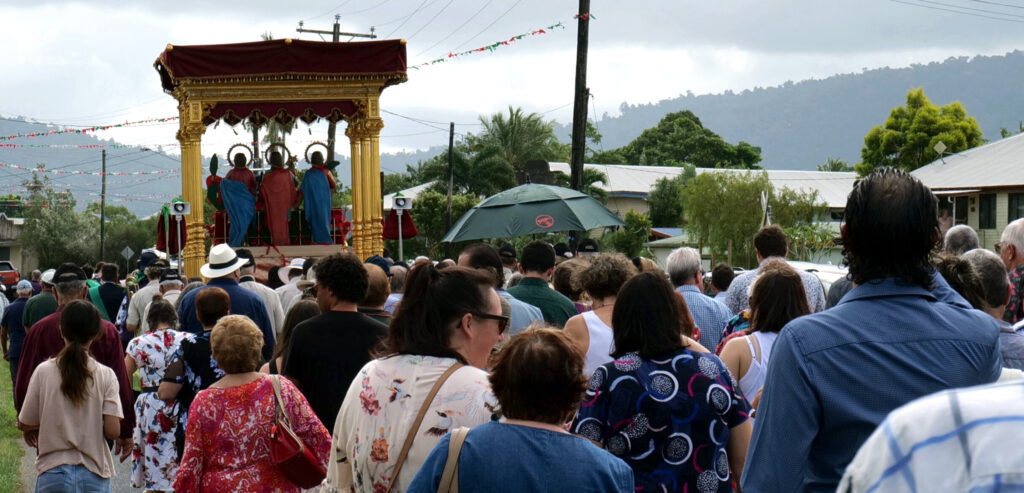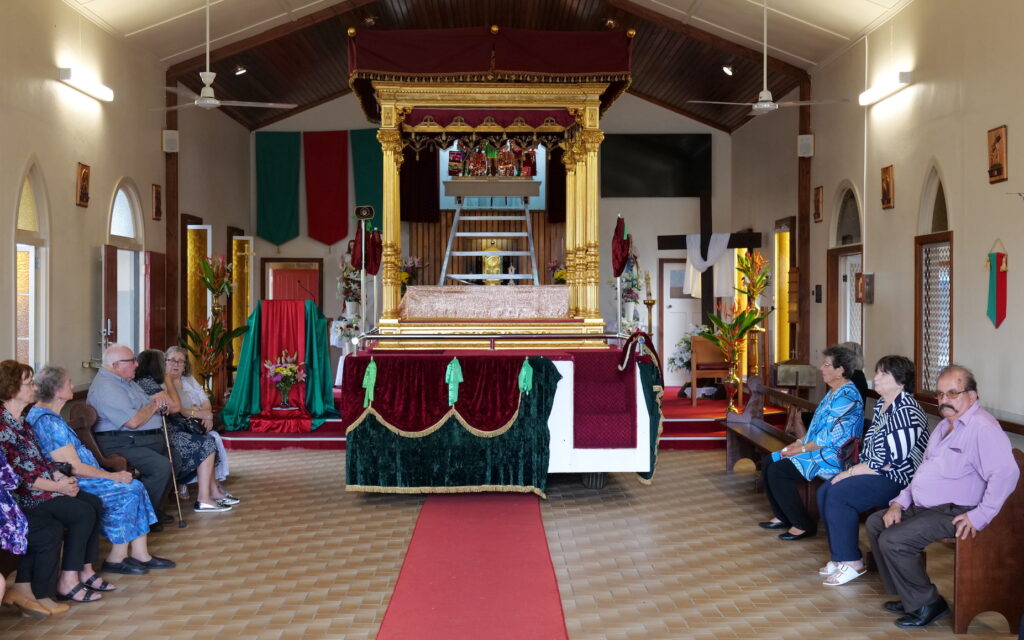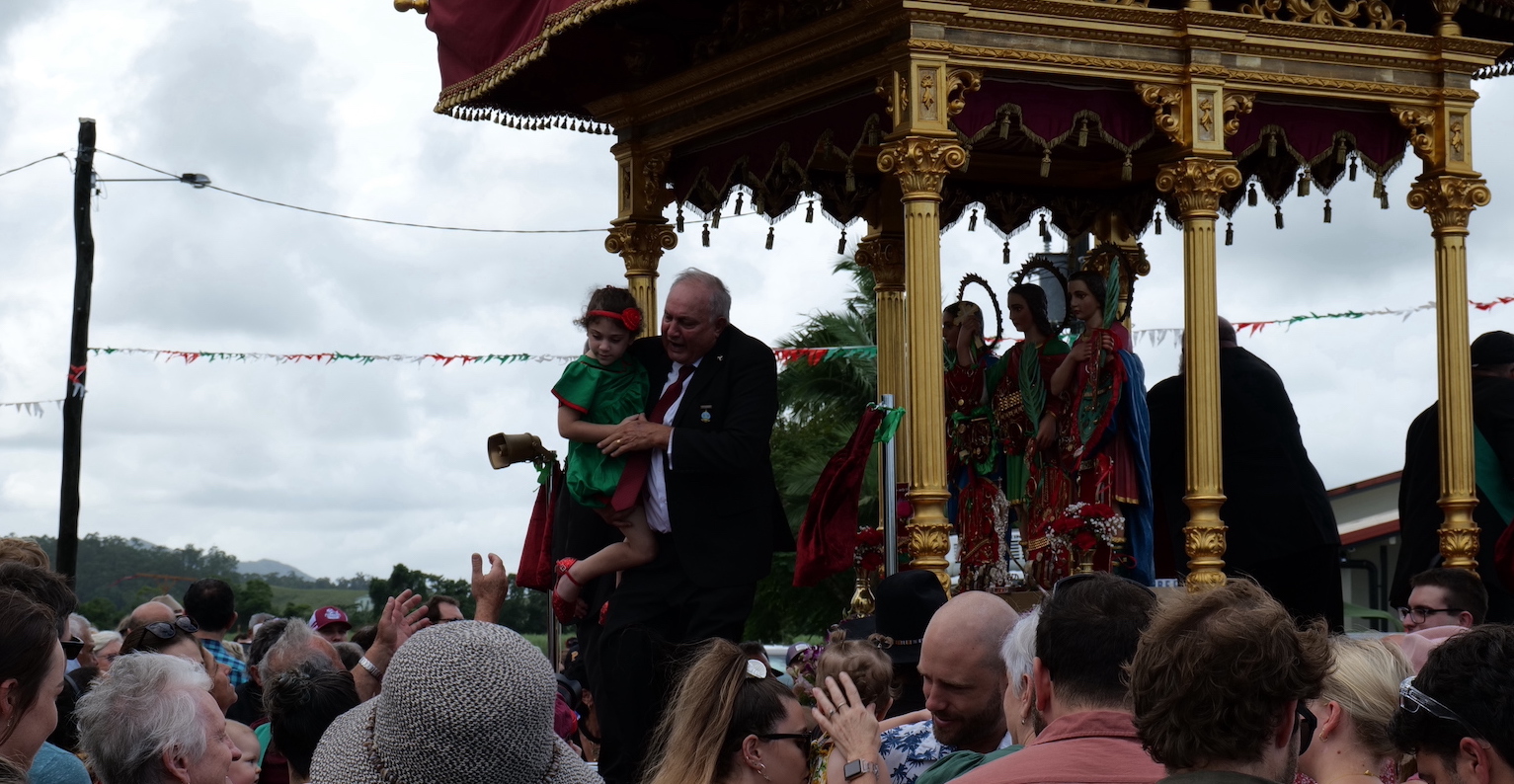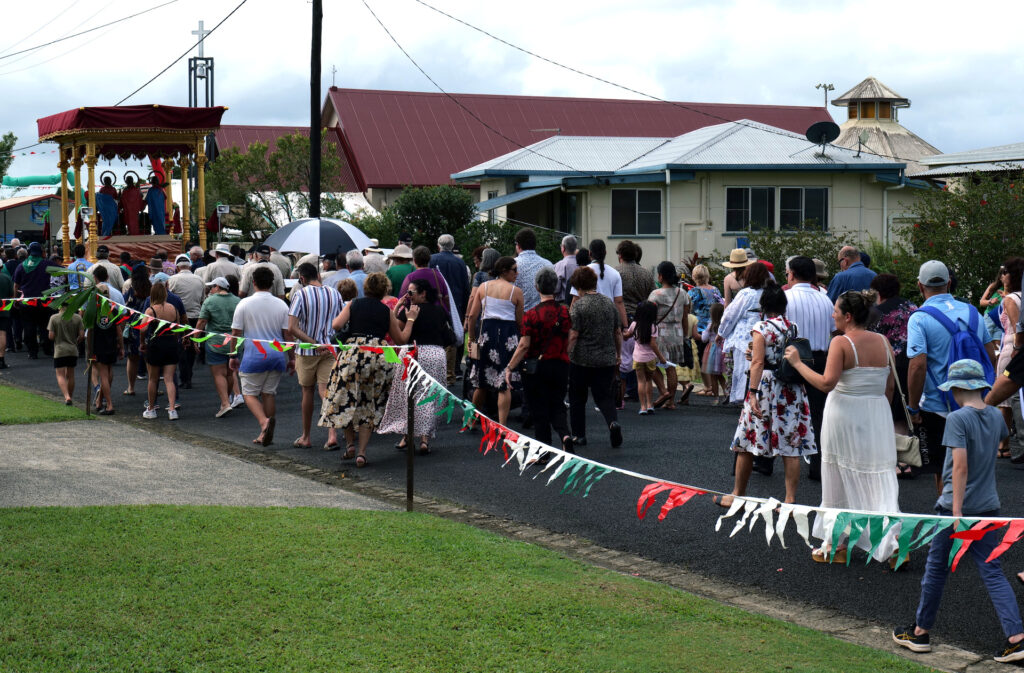The Saints of Silkwood
Held annually in May in a small township near Innisfail, the Three Saints Feast celebrates Sicilian religious traditions and Italian-Australian identity.
By Geoff Ginn and Adam Bowles
This is a 4 minute read, and a 10 minute video, published in June 2024.
Banging firecrackers and the tolling of a single bell announce the start of mass in the small church at Silkwood, filled to overflowing among the cane fields. Well-dressed families, their elders, teenagers, babies, and children settle in as the high mass gets underway. The service proceeds in Italian, with a small choir contributing the sacred prayers.
Above the congregation, the curtain is drawn back to reveal three small and elaborately colourful statues. The figures of saints Alfio, Cirano, and Filadelfio are unveiled on this one day of the year for the feast held in their honour. The saints are moved down from their niche and positioned carefully on a red velvet and gold ‘vara’, a ceremonial vehicle built especially for the purpose. Amid noise and celebration – with cheers, more firecrackers, and babies held high for the saints’ blessing – the relaxed, informal procession moves through the main street of the town. As it concludes and the saints are returned to their niche, the day continues with conviviality, Italian delicacies, music, dancing, and fireworks.
Snapshot: Three Saints Feast, 2023
From Sicily to Silkwood
Silkwood’s Feast of the Three Saints has deep social and cultural roots. A Sicilian tradition of civic pride and religious piety dating back centuries, it was established by migrant families in 1950. Today it attracts visitors from across North Queensland and beyond.
Hundreds of Italian families arrived in North Queensland to work the cane fields from the 1890s, a pattern of migration that accelerated in the 1920s and 1930s. Many came from Sicilian towns and districts like Lentini, Trecastagni, and Sant’Alfio in the Catania region, where a rich religious heritage of saints and miracles, shrines and relics, and art and ritual has inspired the devotions of the faithful from classical times to the present day.
Situated on the volatile slopes of the active volcano Mount Etna, the town of Sant’Alfio is particularly associated with three Christian saints from the era of Roman persecution. Born in Spain in the early 230s, the three brothers Alfio, Cirano, and Filadelfio were martyred in Sicily for their Christian beliefs during the reign of the Roman emperor Tertullian. Religious texts surviving from the centuries that follow record their story as passiones sacri, a style of hagiography ‘which reconstructs the life and martyrdom of saints, largely based on information passed on by the collective memory of popular faith’ (Girola, 2001: 9).
These texts recount how the three brothers were horribly tortured by the order of Roman authorities in their efforts to suppress Christian belief. In these stories their suffering was accompanied by supernatural miracles: the brothers’ hair re-appeared after being shaved off, and their health and beauty were constantly restored despite beatings and injuries. They cured onlookers of ailments and inspired mass conversions – even, it was said, among the Roman soldiers who guarded them.
The Three Saints and their tradition
The Sicilians that arrived in twentieth-century Australia brought with them a vigorous and sociable religious culture centred on the traditions of the three patron saints. But it was only when one migrant, Rosario Tornabene, commissioned the status of the saints from a craftsman in Sicily in 1948 that the Feast itself was initiated in North Queensland. This seems to have been a private resolution, the delayed fulfillment of an earlier promise Tornabene had made to the patron saints of his home town, Sant’Alfio, after a medical crisis in his family (Girola, 2001: 77-100).
Arriving in Silkwood in November 1949, the Three Saints were honoured by a service and procession through the township for the first time on 7 May 1950, followed by food and revelry. These essential elements, celebrated in sequence through the day, have remained a fixture ever since. Now in its eighth decade, the Feast of the Three Saints celebrates an inclusive and multicultural Australia, and the dolce vita of a community that is proud of its Italian heritage and traditions.
Its historian, Stefano Girola, has reflected on how the ‘traditional feasts of southern Italy are far from being unchangeable, rigid repetitions of established customs; they can be adapted with a certain flexibility to different local conditions. What is important is to preserve the essence of the feast, namely the liturgical celebrations followed by the procession of the statues and relics, and the subsequent conviviality and merriment’ (Girola, 2001: 118-19).
The flourishing of Silkwood’s remarkable Feast of the Three Saints illustrates this adaptation in action.
With thanks
Our thanks are extended to Ross Parisi, Cosimo Tedesco, Mario Catalano, and Vera Zappala of the Three Saints Festival organising committee, and to Stefano Girola.
Sources and further reading
Douglass, W. A. 1995. From Italy to Ingham: Italians in North Queensland. St Lucia: University of Queensland Press.
Girola, Stefano. 2001. The Three Saints: Faith History Tradition from Sicily to Queensland. Brisbane: Minerva E & S.
Hempel, J. A. 1959. Italians in Queensland: Some aspects of post-war settlement of Italian immigrants. Department of Demography, Australian National University.
Lo Monaco, L. 1998. St John’s Silkwood: Parish and school 50th Jubilee, 1948-1998. Silkwood, Qld.: Parish of St John’s.
Related articles





